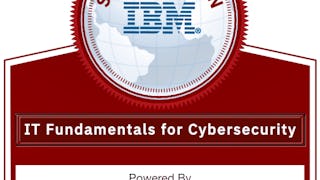![[Featured Image] A public safety dispatcher, one of many civilian DOD jobs, uses a laptop and headset to take a call.](https://images.ctfassets.net/wp1lcwdav1p1/27QRo3sVVB0XzsgktZJLYX/844dd24f123478b2ae70988b75470741/GettyImages-1456583865.jpg?w=330&h=216&q=60&fit=fill&f=faces&fm=jpg&fl=progressive)
DOD Jobs: Civilian Careers with the Department of Defense
Explore DOD jobs, which span hundreds of career fields, including administrative, information security, engineering, law enforcement, and HR.
February 4, 2025
Article
An average of 16,800 jobs are expected to open in computer and information security each year, 2022-2032*. Here, you’ll find the resources you need to make your next cybersecurity career move.

Gain specialized knowledge and in-demand skills with leading organizations

Skills you'll gain: Network Security, Incident Response, Computer Security Incident Management, Hardening, Stakeholder Communications, Intrusion Detection and Prevention, Security Management, Threat Management, Cybersecurity, Network Protocols, Network Architecture, Event Monitoring, Cyber Risk, TCP/IP, Threat Detection, Operating Systems, File Systems, Security Controls, Debugging, Python Programming
Build toward a degree
Beginner · Professional Certificate · 3 - 6 Months

Skills you'll gain: Cyber Threat Hunting, Incident Response, IT Service Management, Identity and Access Management, Cloud Computing, Governance Risk Management and Compliance, Information Technology Infrastructure Library, Endpoint Security, Malware Protection, Penetration Testing, Linux, Computer Security Incident Management, Database Management, Network Security, Networking Hardware, TCP/IP, Cybersecurity, Cyber Threat Intelligence, Interviewing Skills, Cyber Security Assessment
Build toward a degree
Beginner · Professional Certificate · 3 - 6 Months

Skills you'll gain: IT Service Management, Cloud Computing, Governance Risk Management and Compliance, Information Technology Infrastructure Library, Malware Protection, Identity and Access Management, Linux, Incident Response, Networking Hardware, TCP/IP, Cybersecurity, Network Security, Network Protocols, Threat Modeling, Linux Servers, Cloud Security, Operating Systems, Endpoint Detection and Response, NIST 800-53, Regulatory Compliance
Beginner · Specialization · 3 - 6 Months
Ready to advance your cybersecurity analyst career? Roles in computer and information security earn more than twice the average salary for all occupations, so you have plenty of high-paying career paths to choose from*. As a mid-level or advanced cybersecurity analyst, you may begin to apply for certified analyst roles, such as CompTIA cybersecurity analyst (CySA+). Or, you might transition into a specialized role like ethical hacker or computer forensic investigator. Learn more about how to prepare for more advanced cybersecurity roles and how Coursera can help:
Obtaining a security clearance can be difficult, since the requirements for higher-level intelligence jobs can be quite stringent. But as long as you have not committed any serious crimes and have a relatively clean history, you will likely gain the security clearance needed to be officially hired. In addition to security clearance, many information security jobs with the government or related organizations also require certain baseline cybersecurity certifications to validate their knowledge of best practices.
CompTIA Security+ is a widely recognized cybersecurity certification that validates the essential knowledge and skills needed to secure computer systems and protect data. It covers a wide range of topics related to network security, threats and vulnerabilities, identity management, access control, cryptography, and security best practices. CompTIA Security+ is vendor-neutral, meaning it provides a broad understanding of cybersecurity principles and is not tied to any specific technology or platform.
Penetration testing, commonly referred to as pen testing or “ethical hacking,” is the process of conducting a simulated cyberattack on an organization’s computer system. Pen testing is an important technique used by cybersecurity professionals for exposing database vulnerabilities and network security flaws that could be exploited by hackers. With so much of today’s critical business as well as personal information accessible through the internet, cyberattacks can be incredibly costly or even dangerous, making this process of identifying vulnerabilities essential.
Pen tests may use a variety of methods to execute a cyberattack, including brute force attacks, SQL injection, phishing, or even hardware devices. In order to simulate real-world cyberattacks as closely as possible, a “single-blind” test is typically carried out by an outside cybersecurity or IT security analyst with no prior knowledge of the network security systems in place, and in a “double-blind” test the company’s own IT and cybersecurity team is not given advance notice. Pen testing procedures also vary depending on whether the organization wants to simulate an external attack from an outside hacker or an internal attack from a disgruntled employee.
*US Bureau of Labor Statistics. “Occupational Outlook Handbook: Computer and Information Technology: Information Security Analysts, https://www.bls.gov/ooh/computer-and-information-technology/information-security-analysts.htm#tab-1.” Accessed February 7, 2024.